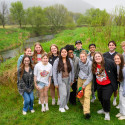Fossil find pushes fungi age back 60 million years
Fossils from a Wisconsin roadcut show clearly that fungi and green plants moved from water onto land at about the same time, bolstering the theory that fungi helped plants successfully invade the land.
The newly discovered fossils — microscopic spores and threads in sediments dating from 460 to 455 million years ago — push the origin of land-based fungi back some 55 to 60 million years to about the same era that green plants invaded land.
Colleagues from the University of California-Berkeley and UW–Madison report the discovery of the fossil fungi in the Sept. 15 issue of Science.
“The presence of both organisms at the same time suggests that there could have been such an interaction, and that organisms even then were interdependent,” says Dirk Redecker, a postdoctoral researcher at Berkeley.
Plant/fungus interactions are widespread today, with between 80 and 90 percent of all green plants forming associations with so-called mycorrhizal fungi. These fungi grow around and into plant roots and help them absorb minerals and water, giving plants a substantial competitive advantage, says coauthor Linda K. Graham, a professor of botany and environmental studies at UW–Madison.
“Plants without mycorrhizal fungi are competitively inferior,” Graham says. “Though they won’t die, in a highly competitive situation or places with a dearth of resources, mycorrhizal fungi function as an auxiliary root system to provide additional nutrients.”
The researchers caution that the fossil fungi they discovered and report in Science show no evidence of an association with green plants. However, similar modern fungi from the genus Glomus form a simple association with modern liverworts and hornworts, relatives of the only group of land plants around 460 million years ago.
In addition, mycorrhizal fungi have been found in fossils as old as 400 million years, in company with later, more evolved vascular plants.
Together, these provide strong circumstantial evidence that fungi played a major role in helping plants move successfully onto land, Redecker says.
Graham obtained the fossil-bearing rocks from a roadcut near Madison, not knowing what kinds of fossils they contained. It wasn’t until undergraduate Robin Kodner etched the rocks with strong acid that she and Graham saw tiny structures that a colleague suggested might be fossilized fungal spores.
The two sought out Redecker, an expert in fungi evolution, and he was able to identify them as spores and hyphae — tiny root-like threads — of fungi.
Colonization of the land masses by the first land plants is believed to have happened in the Ordovician period 440 million to 550 million years ago, Redecker says. However, no pieces of land plants large enough to see without using a microscope have yet been found from that epoch. This may be due to the fact that the first land plants mainly consisted of soft, quickly decaying tissue like today’s hornworts and liverworts. Only fossil spores and microscopically small parts of resistant protective tissue indicating the presence of those plants have been found.
Tags: research




